1963. A pivotal year in horology history. It is the year that undoubtedly marks the last great epoch of the “utilitarian” mechanical horology. At this time is created the legendary chronograph Heuer Carrera.
Jack Heuer transcends the Helvetic neo-classicism of the 50s to introduce functionalism into the chronograph. The reason behind this decision? Mechanical sports.
The connivances between mechanical sports and Tag Heuer are old and intimately linked to the La Chaux-de-Fonds’ brand history. This adventure began before the Great War. In 1963, Tag had already been manufacturing pocket watches dedicated to sports timing for more than fifty years. For instance, the “Mikrographe” vintage was manufactured at the start of the 20th Century or, some years before the Carrera, the “Rally Master”, a dashboard chronograph.
As an opposition to what the neophyte may presume, the Carrera name is not linked to Porsche; it was rather inspired by the mythical race of the 50s, the Carrera Panamericana AKA “Pan Am”. What can be seen as an astonishing paradox is that before 1963, this event had not occurred since 1955, following a decision of Mexican authorities. This interruption was the result of the psychological trauma caused by the tragic accident of the Mercedes 300 SLR at the 24H of the Mans 1955… However, Jack Heuer turned out to be a visionary by betting on the resurrection of this anthology race... The event is back on track since 1988.
It is this vision, this intuition, this understanding which are the forging factors of the Carrera history…
Heuer Carrera 45 Dato "Cobra Shelby" 3147
Likely to be seen as something minor nowadays, one was aware that even the most minor detail was relevant in performance research at the time.
Heuer applied the solutions giving a maximum readability to military watches of the interwar period to sports watches: greater aperture and black dial for a maximum of contrast.
The first reference of the Carrera is the 2447. Bicompax, panda or full black, it is a round watch of 36mm (which was relatively big for the time). Animated by a Valjoux 72, a standard movement during the after-war; its frequency is at 18000 vph for 45 hours of power reserve.
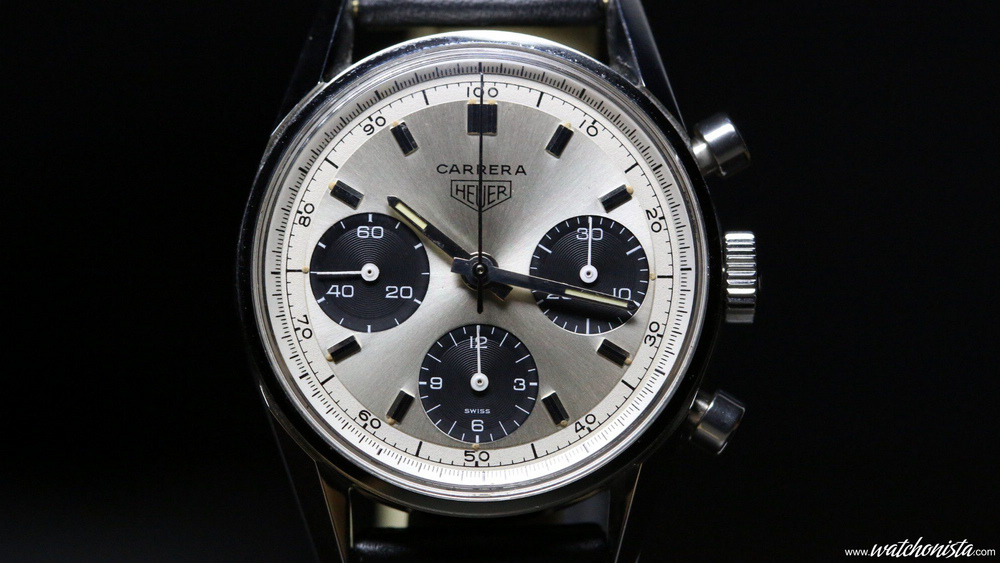
It presents numerous similarities with the Rolex “Pré-Daytona” ref. 6238: the calibre, the dial and the push-pieces. What is even better is that the future 6239, just like the Carrera, will adopt the name of an automobile event across the Atlantic: Daytona.
However, even if the Daytona and the Carrera started off at almost the same point (in the 60s, the products were less “identity-oriented” than today) and were presented in the same year (the Daytona also celebrates its 50 years this year), they had diametrically opposed destinies.
On the one hand, the Daytona evolved very little, as much in terms of motorization as aesthetics, since Rolex privileged reliability and durability above all.
On the other hand, the Carrera became a permanent, aesthetic and technical laboratory.
Here, we have to make reference to the Heuer Carrera 45 Dato « Cobra Shelby » 3147. In fact, in 1963, it was rare to have “branded” watches (the 70s and 80s were the Golden Age of the “branded” watches).
It is thus due to the logo of the British constructor that the 3147 will be of more interest to us than the 2447.
Despite the legitimacy and the explosive potential of a partnership between the AC Cobra and Tag Heuer niche constructor, the Dato 45 was not a commercial watch.
In the 60s, Carol Shelby, ex-racing driver (he won the 24h du Mans in 1959 Mans with Aston Martin), decided to create the American racing car; he turned to Ford, which was able to supply the motor and the money and was helped by AC, a British constructor which owned the European know-how in terms of chassis.
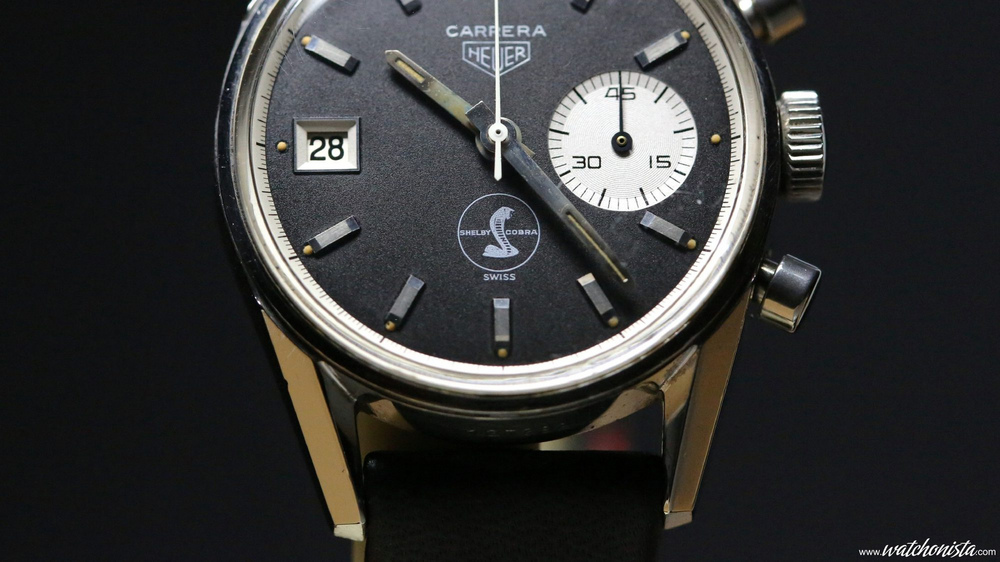
The AC Cobra was born; it would know a qualified success: sales during the 60s did not exceed 1000 copies, divided into diverse versions.
The car is too early and too pointed, it precedes the Muscle Cars era; however, the latter will aim higher in the objective set by the Cobra Shelby: be as powerful as the GTs of the moment for much less money.
Shelby had opted for a compromise between the dynamic qualities of the automobile and its cost. The Muscle Cars would be much more radical, leaving behind all equilibrium in terms of behavior, in favor of atmospherics V8s under steroids, at dumped prices…
To motivate sales forces, the Ford group asked Jack Heuer to manufacture its Dato 45, declined into two series : the first (1966-67), Bicompax and the second (1968-69) more radical, Monocompax, the latter consisting of the AC Cobra initials.
[URL=http://www.watchonista.com/2914/watchonista-blog/watchographer/pictures/heuer-carrera-45-dato-cobra-shelby-later-black-ref-31-4]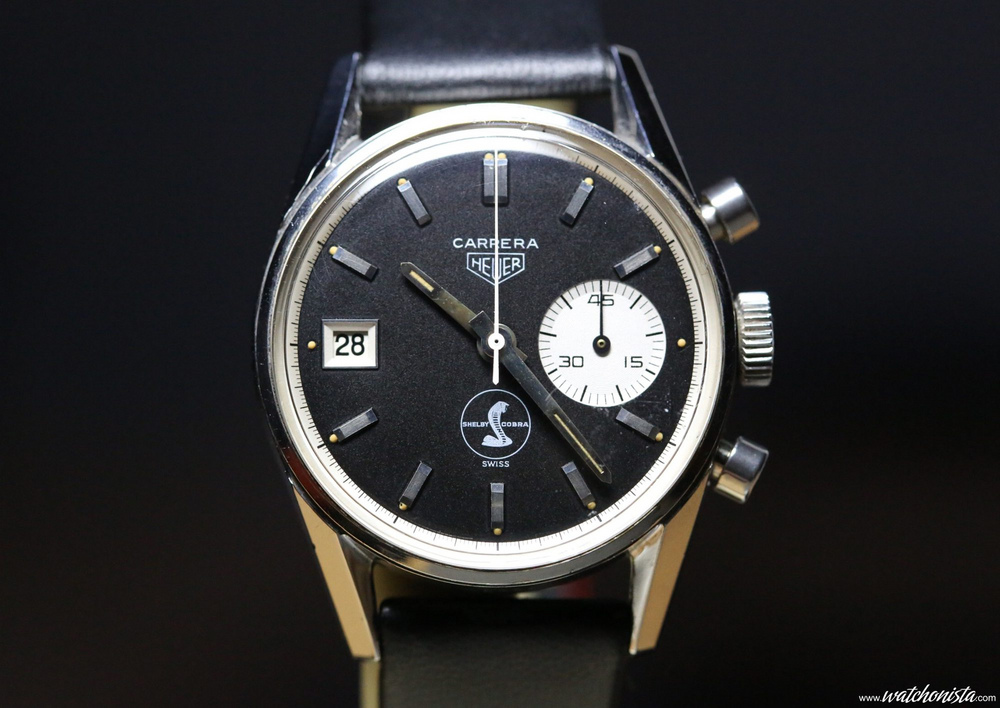
It is obviously this version which will be of interest here since it prefigures various heavy trends through its aesthetics. First and foremost, the automobile/horology partners which are henceforth the forgotten passage of any large-scale watchmaking firm.
The dial is decorated with an automobile brand’s logo (a first?!) And what a logo! AC’s Cobra is incredibly aggressive and perfectly corresponds to Shelby’s sports vocation: combine the best of European and American automobile.
Then, the watch proposes a big date and a big white timer of graduated minutes up to 45. Obviously, everything is done in the scope of a maximum readability: with its great aperture at the dial, the watch cuts more than the announced 36mm.
The case is the embodiment of simplicity; its horns are very long which is logical given its size. Besides, the current Carreras will conserve this characteristic but with a greater-sized case.
Furthermore, the watch is motored by an unusual caliber (in the Carreras only; it was relatively common at the time) of manual chronograph: the Landeron 189, 31mm in diameter for 6.85mm in width. It has a frequency of 18000 vibrations per hour for 42 hours of power reserve.
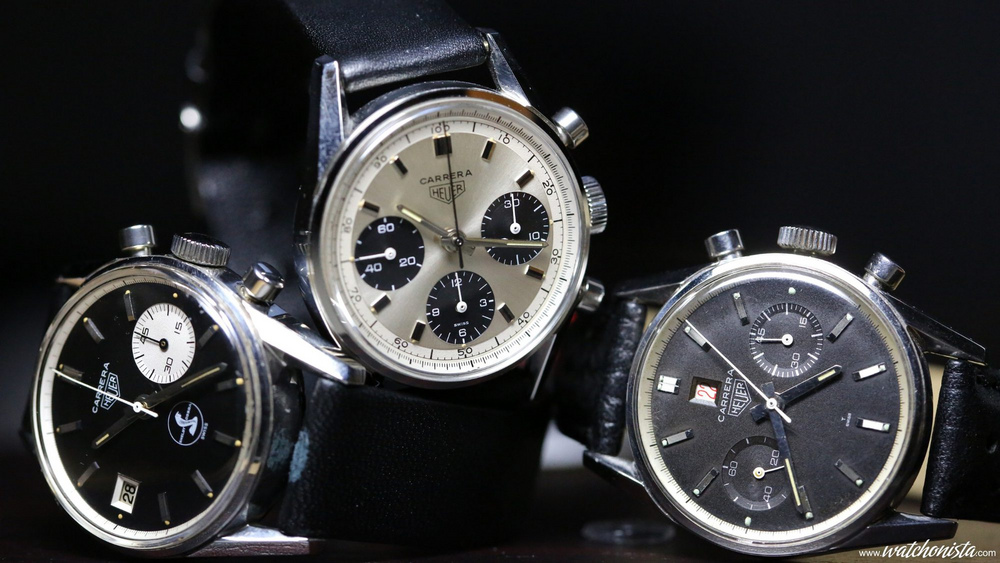
It is to be noted that the steel case resonates quite a lot and that the sound characteristic of 2.5Hz is quite audible for such a small watch.
If the Heuer Carrera 45 Dato “Cobra Shelby” is almost impossible to find by chance, you may find a 45 Dato without logo for approximately 3’500 CHF…
Which is much less expensive than an original Cobra Shelby, because let’s admit it, it is much more simple (and economic!) to wear a vintage watch than to drive an appropriate car.
Jack Heuer transcends the Helvetic neo-classicism of the 50s to introduce functionalism into the chronograph. The reason behind this decision? Mechanical sports.
The connivances between mechanical sports and Tag Heuer are old and intimately linked to the La Chaux-de-Fonds’ brand history. This adventure began before the Great War. In 1963, Tag had already been manufacturing pocket watches dedicated to sports timing for more than fifty years. For instance, the “Mikrographe” vintage was manufactured at the start of the 20th Century or, some years before the Carrera, the “Rally Master”, a dashboard chronograph.
As an opposition to what the neophyte may presume, the Carrera name is not linked to Porsche; it was rather inspired by the mythical race of the 50s, the Carrera Panamericana AKA “Pan Am”. What can be seen as an astonishing paradox is that before 1963, this event had not occurred since 1955, following a decision of Mexican authorities. This interruption was the result of the psychological trauma caused by the tragic accident of the Mercedes 300 SLR at the 24H of the Mans 1955… However, Jack Heuer turned out to be a visionary by betting on the resurrection of this anthology race... The event is back on track since 1988.
It is this vision, this intuition, this understanding which are the forging factors of the Carrera history…
Heuer Carrera 45 Dato "Cobra Shelby" 3147
Likely to be seen as something minor nowadays, one was aware that even the most minor detail was relevant in performance research at the time.
Heuer applied the solutions giving a maximum readability to military watches of the interwar period to sports watches: greater aperture and black dial for a maximum of contrast.
The first reference of the Carrera is the 2447. Bicompax, panda or full black, it is a round watch of 36mm (which was relatively big for the time). Animated by a Valjoux 72, a standard movement during the after-war; its frequency is at 18000 vph for 45 hours of power reserve.

It presents numerous similarities with the Rolex “Pré-Daytona” ref. 6238: the calibre, the dial and the push-pieces. What is even better is that the future 6239, just like the Carrera, will adopt the name of an automobile event across the Atlantic: Daytona.
However, even if the Daytona and the Carrera started off at almost the same point (in the 60s, the products were less “identity-oriented” than today) and were presented in the same year (the Daytona also celebrates its 50 years this year), they had diametrically opposed destinies.
On the one hand, the Daytona evolved very little, as much in terms of motorization as aesthetics, since Rolex privileged reliability and durability above all.
On the other hand, the Carrera became a permanent, aesthetic and technical laboratory.
Here, we have to make reference to the Heuer Carrera 45 Dato « Cobra Shelby » 3147. In fact, in 1963, it was rare to have “branded” watches (the 70s and 80s were the Golden Age of the “branded” watches).
It is thus due to the logo of the British constructor that the 3147 will be of more interest to us than the 2447.
Despite the legitimacy and the explosive potential of a partnership between the AC Cobra and Tag Heuer niche constructor, the Dato 45 was not a commercial watch.
In the 60s, Carol Shelby, ex-racing driver (he won the 24h du Mans in 1959 Mans with Aston Martin), decided to create the American racing car; he turned to Ford, which was able to supply the motor and the money and was helped by AC, a British constructor which owned the European know-how in terms of chassis.

The AC Cobra was born; it would know a qualified success: sales during the 60s did not exceed 1000 copies, divided into diverse versions.
The car is too early and too pointed, it precedes the Muscle Cars era; however, the latter will aim higher in the objective set by the Cobra Shelby: be as powerful as the GTs of the moment for much less money.
Shelby had opted for a compromise between the dynamic qualities of the automobile and its cost. The Muscle Cars would be much more radical, leaving behind all equilibrium in terms of behavior, in favor of atmospherics V8s under steroids, at dumped prices…
To motivate sales forces, the Ford group asked Jack Heuer to manufacture its Dato 45, declined into two series : the first (1966-67), Bicompax and the second (1968-69) more radical, Monocompax, the latter consisting of the AC Cobra initials.
[URL=http://www.watchonista.com/2914/watchonista-blog/watchographer/pictures/heuer-carrera-45-dato-cobra-shelby-later-black-ref-31-4]

It is obviously this version which will be of interest here since it prefigures various heavy trends through its aesthetics. First and foremost, the automobile/horology partners which are henceforth the forgotten passage of any large-scale watchmaking firm.
The dial is decorated with an automobile brand’s logo (a first?!) And what a logo! AC’s Cobra is incredibly aggressive and perfectly corresponds to Shelby’s sports vocation: combine the best of European and American automobile.
Then, the watch proposes a big date and a big white timer of graduated minutes up to 45. Obviously, everything is done in the scope of a maximum readability: with its great aperture at the dial, the watch cuts more than the announced 36mm.
The case is the embodiment of simplicity; its horns are very long which is logical given its size. Besides, the current Carreras will conserve this characteristic but with a greater-sized case.
Furthermore, the watch is motored by an unusual caliber (in the Carreras only; it was relatively common at the time) of manual chronograph: the Landeron 189, 31mm in diameter for 6.85mm in width. It has a frequency of 18000 vibrations per hour for 42 hours of power reserve.

It is to be noted that the steel case resonates quite a lot and that the sound characteristic of 2.5Hz is quite audible for such a small watch.
If the Heuer Carrera 45 Dato “Cobra Shelby” is almost impossible to find by chance, you may find a 45 Dato without logo for approximately 3’500 CHF…
Which is much less expensive than an original Cobra Shelby, because let’s admit it, it is much more simple (and economic!) to wear a vintage watch than to drive an appropriate car.

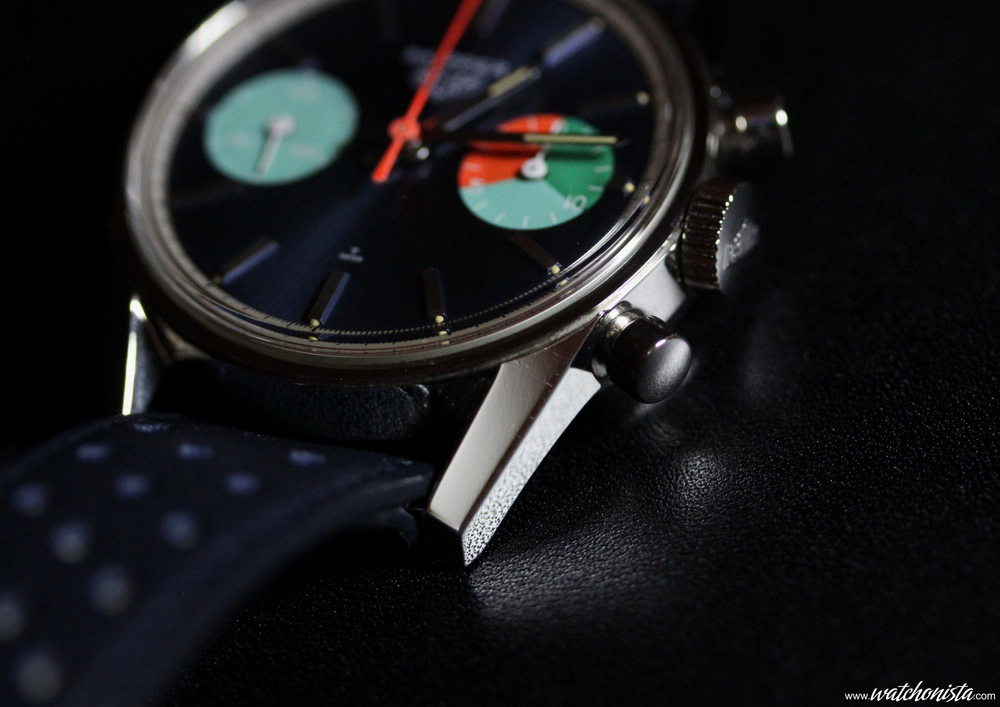
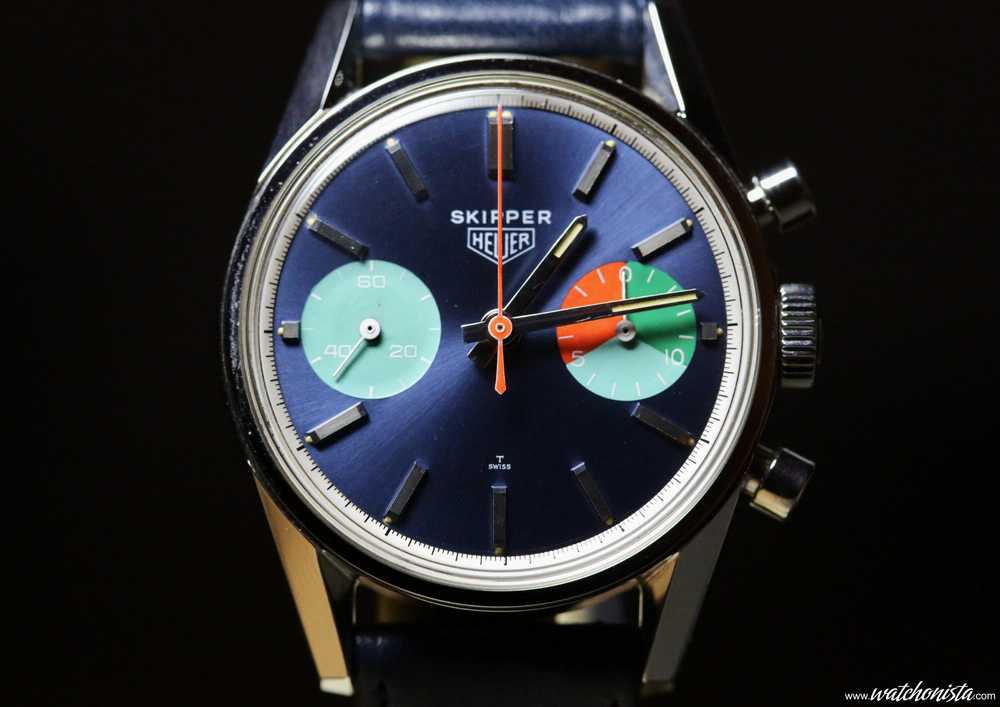
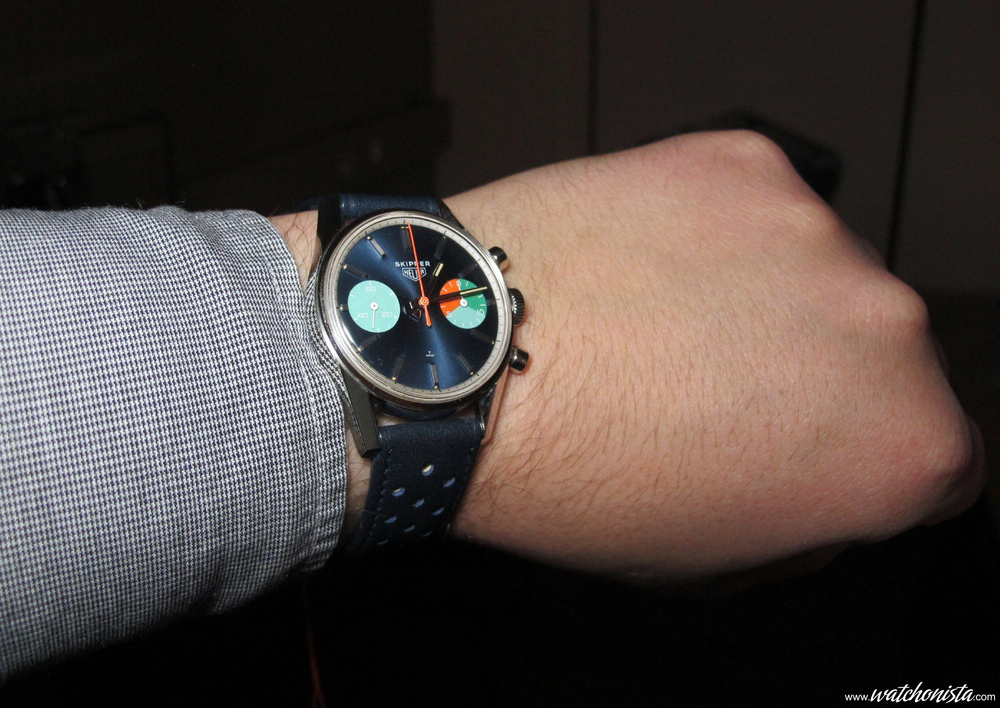
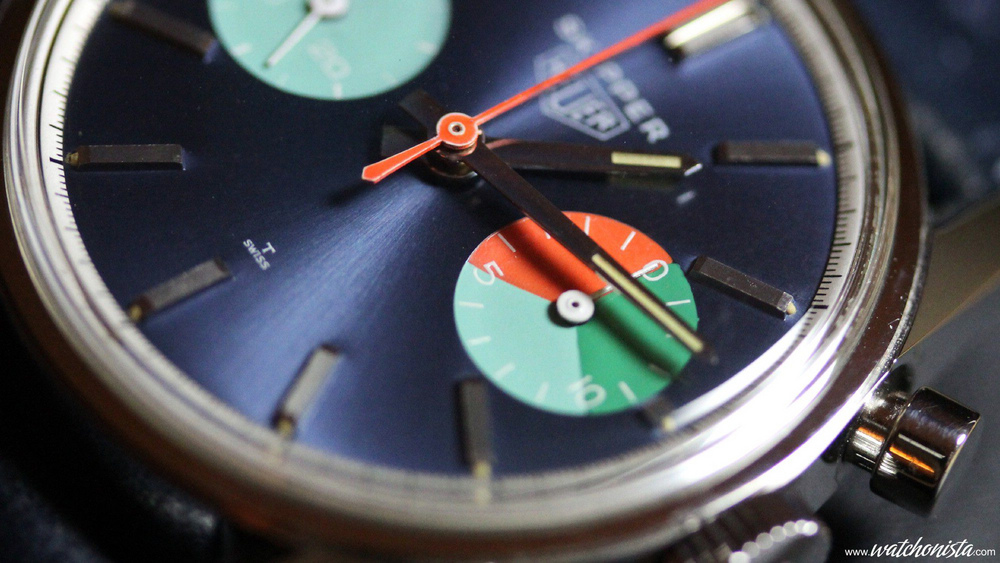
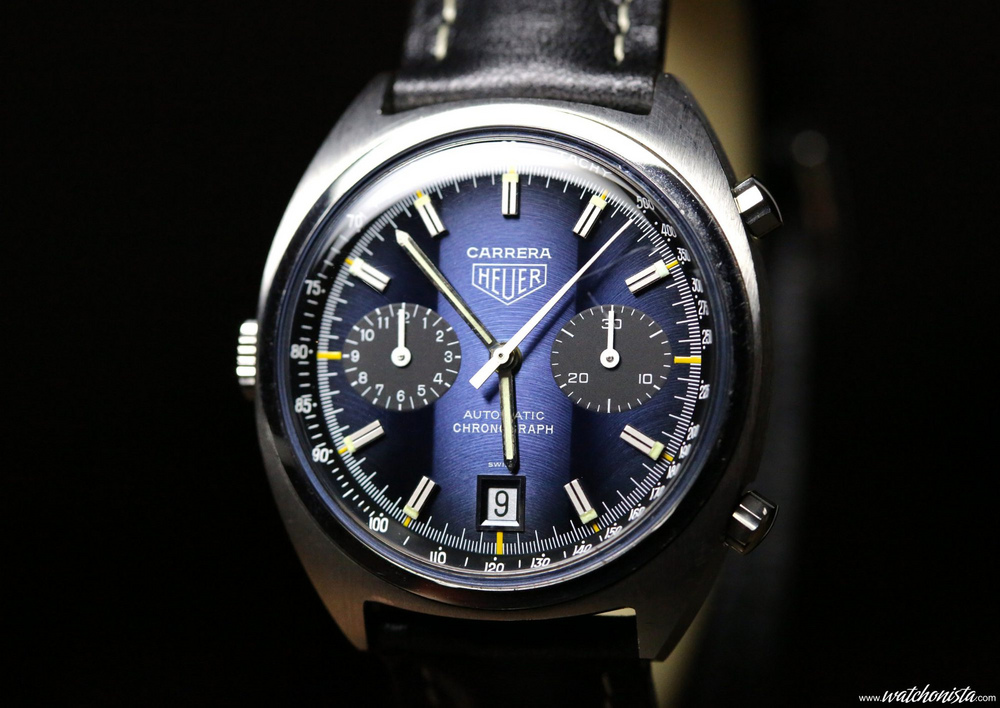
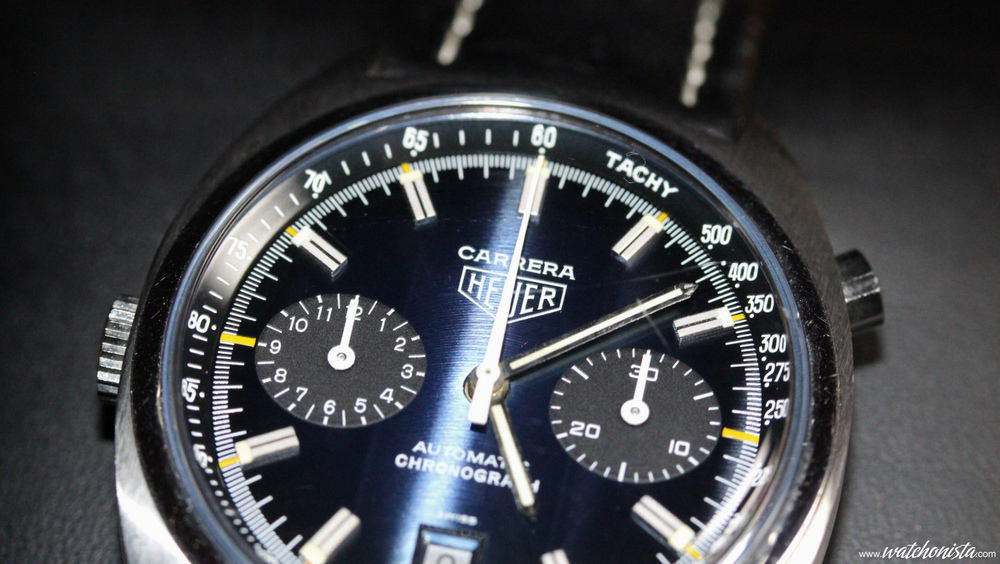
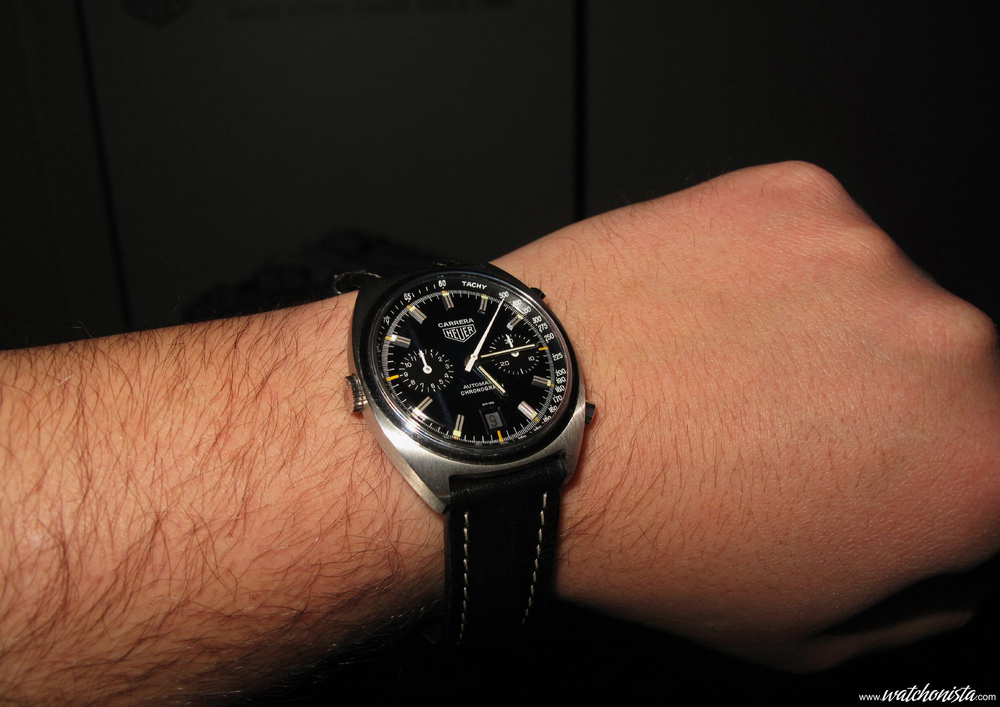
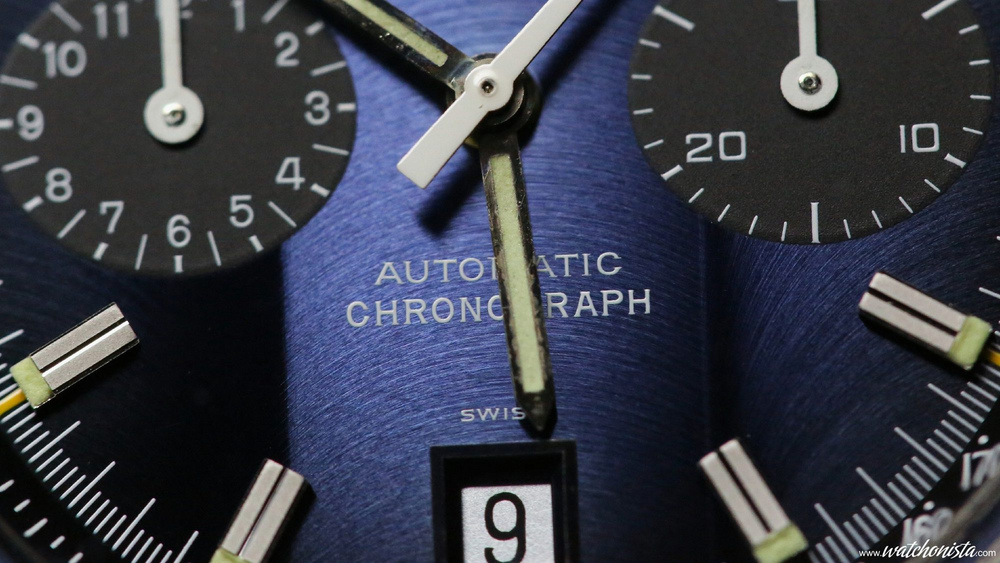
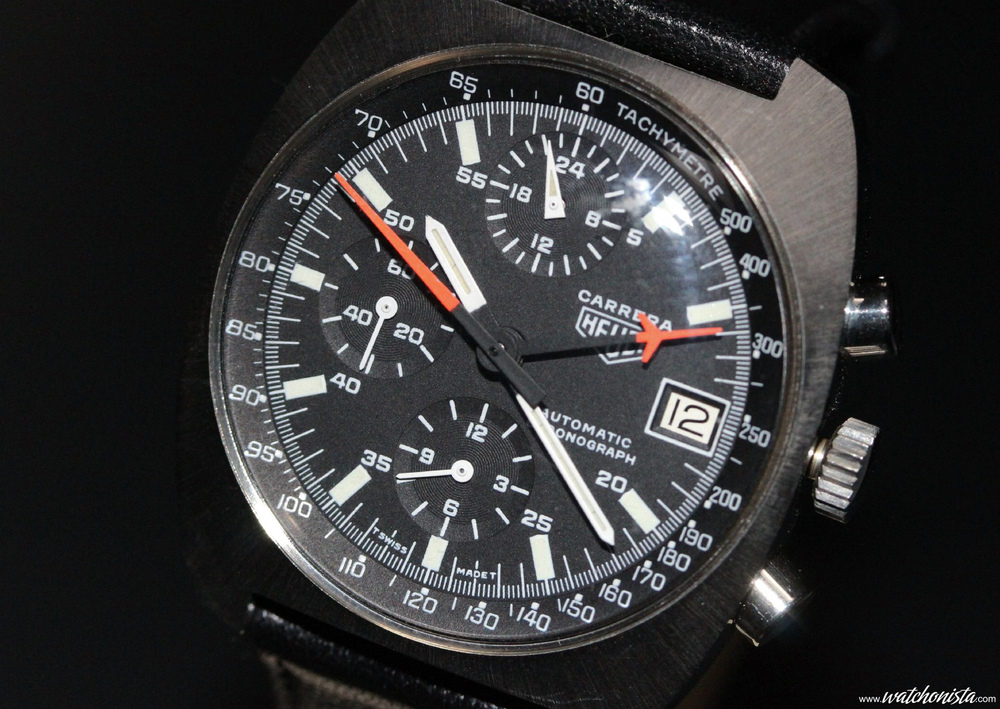
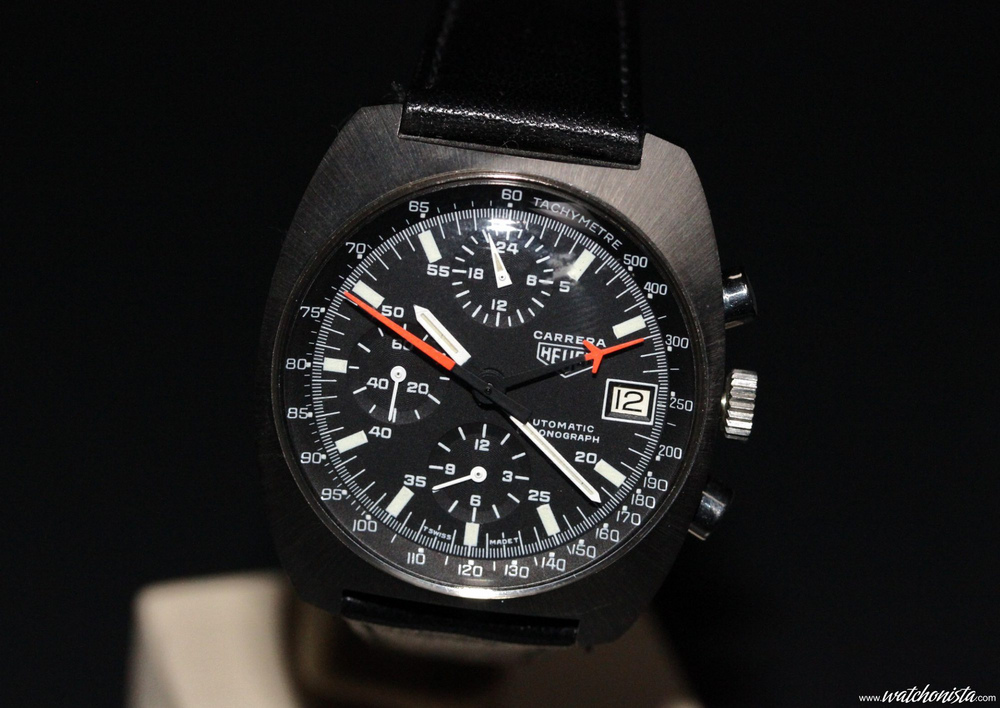



















Comment